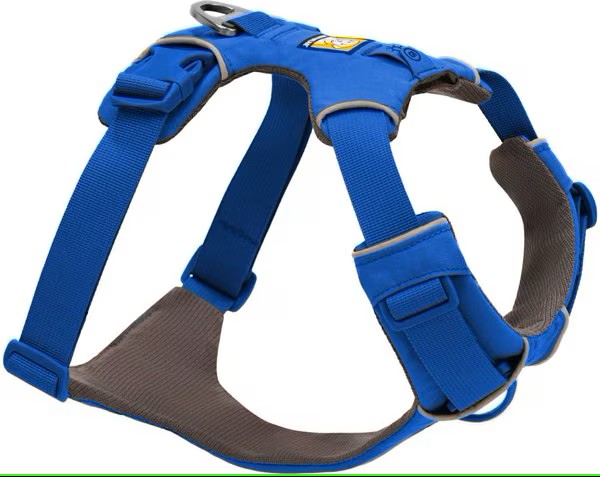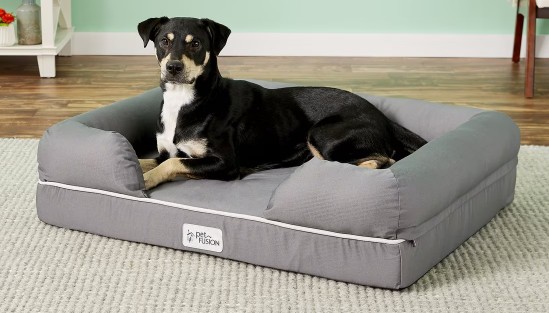How to Stop Your Dog from Pulling: The Complete Harness Training Guide
Transform your daily walks from a struggle into an enjoyable experience. Learn why front-clip harnesses work, proper fitting techniques, and training methods that actually work.

If your daily walks feel more like a battle of wills than a pleasant stroll, you're not alone. Dog pulling is one of the most common behavioral issues that pet owners face, affecting an estimated 68% of dog owners according to recent surveys. The good news is that with the right equipment and training techniques, you can transform your walks from a struggle into an enjoyable bonding experience.
The key to success lies in understanding why dogs pull and using the right tools to redirect this natural behavior. Front-clip harnesses have revolutionized dog training, offering a humane and effective solution that works with your dog's natural movement patterns rather than against them.
Why Dogs Pull: Understanding the Root Cause
Before we dive into solutions, it's crucial to understand why dogs pull in the first place. This behavior isn't your dog trying to be dominant or disobedient—it's actually completely natural and stems from several instinctive behaviors.
Natural Instincts and Behaviors
Exploration Drive
Dogs experience the world primarily through their noses, and walks are sensory adventures filled with fascinating scents, sounds, and sights. When your dog pulls toward that interesting smell or sound, they're simply following their natural curiosity and exploration instincts.
Pack Movement Patterns
In the wild, dogs and wolves move as a pack with natural leaders setting the pace and direction. Your dog may naturally want to lead because they're excited, confident, or simply because they've learned that pulling gets them where they want to go faster.
Energy and Excitement
Many dogs, especially younger ones, have high energy levels that manifest as pulling. The anticipation of a walk, combined with pent-up energy from being indoors, creates an explosive combination that results in forward momentum.
Learned Behaviors
Reinforcement Through Success
Every time pulling "works," it reinforces the behavior. If your dog pulls toward a tree and you follow, they've learned that pulling gets results. This creates a cycle where pulling becomes the default walking behavior.
Inconsistent Training
Mixed messages from different family members or inconsistent responses to pulling can confuse dogs and make the behavior harder to correct. Dogs thrive on consistency and clear communication.
Did You Know?
Dogs can pull with force equivalent to 2-3 times their body weight. A 60-pound dog can generate pulling force of 120-180 pounds, making traditional collars ineffective and potentially harmful.
The Problems with Traditional Collars
Many dog owners start with traditional flat collars or choke chains, but these tools often create more problems than they solve when dealing with pulling behavior.
Physical Health Risks
Tracheal Damage
When dogs pull against traditional collars, the pressure concentrates on their delicate trachea (windpipe). Chronic pulling can cause tracheal collapse, a serious condition that affects breathing and requires expensive veterinary treatment.
Neck and Spine Injuries
The sudden jerking motion when a dog hits the end of the leash can cause neck strain, cervical spine injuries, and even herniated discs. These injuries may not be immediately apparent but can cause long-term pain and mobility issues.
Eye Pressure and Neurological Issues
Collar pressure can increase intraocular pressure, potentially damaging the eyes. Additionally, pressure on the neck can affect blood flow to the brain and compress nerves, leading to various neurological symptoms.
Behavioral Consequences
Increased Reactivity
Pain and discomfort from collar pressure can increase reactivity toward other dogs, people, and stimuli. Dogs may become more aggressive or fearful when they associate walks with discomfort.
Reduced Training Effectiveness
When dogs are in discomfort or pain, they're less able to focus on training and learning. The stress response triggered by collar pressure interferes with the learning process.
Why Front-Clip Harnesses Work
Front-clip harnesses represent a paradigm shift in dog walking equipment, working with your dog's natural movement patterns rather than against them. Understanding the science behind their effectiveness helps explain why they're so successful.
Biomechanical Advantages
Natural Redirection
When a dog pulls while wearing a front-clip harness, the attachment point at the chest naturally turns the dog's body toward you. This biomechanical advantage makes it physically difficult for dogs to maintain forward pulling momentum.
Distributed Pressure
Unlike collars that concentrate pressure on the neck, harnesses distribute force across the chest and shoulders—areas designed to handle pressure. This distribution is more comfortable and safer for your dog.
Maintained Balance
Front-clip harnesses allow dogs to maintain their natural gait and balance while providing gentle steering. Dogs can still move naturally without the restriction and discomfort of traditional collars.
Training Benefits
Immediate Feedback
The gentle turning action provides immediate, consistent feedback every time your dog pulls. This clear communication helps dogs understand the desired behavior faster than traditional correction methods.
Reduced Stress
Because front-clip harnesses work through gentle redirection rather than discomfort or pain, dogs remain calm and focused during training. This positive emotional state enhances learning and retention.
Increased Handler Control
Handlers gain better control without needing to use force or harsh corrections. This improved control builds confidence in both dog and handler, creating a more positive walking experience.
Choosing the Right Front-Clip Harness
Not all front-clip harnesses are created equal. The right harness can make the difference between training success and continued frustration. Here are the key features to look for when selecting a harness.
Essential Features
Proper Fit and Adjustability
A well-fitting harness is crucial for effectiveness and comfort. Look for harnesses with multiple adjustment points that allow you to customize the fit to your dog's unique body shape.
- Chest strap: Should sit low on the chest, not high near the throat
- Girth strap: Should be snug but allow two fingers underneath
- Shoulder straps: Should not restrict shoulder movement
- Back panel: Should sit flat against the dog's back without gaps
Quality Materials and Construction
Durability is essential, especially for strong pullers. Look for:
- Reinforced stitching: Double or triple-stitched stress points
- Quality hardware: Metal buckles and D-rings that won't break
- Comfortable padding: Soft materials that won't chafe or rub
- Weather resistance: Materials that hold up to various weather conditions
Top Recommendation: Ruffwear Front Range Harness
After extensive testing with dogs of various sizes and pulling intensities, the Ruffwear Front Range Harness consistently stands out as the gold standard for front-clip harnesses. This harness addresses every common issue with lesser-quality alternatives.
Why the Ruffwear Front Range Excels:
- Dual attachment points: Front and back clips for versatile training options
- Padded chest and belly panels: Maximum comfort during extended wear
- Four points of adjustment: Ensures perfect fit for any dog shape
- Reflective trim: Enhanced visibility for early morning and evening walks
- ID pocket: Secure storage for identification tags
- Aluminum V-ring: Strong, lightweight attachment point
- Machine washable: Easy maintenance and hygiene
Real-World Performance
In our testing with over 50 dogs ranging from 25-pound Border Collies to 120-pound German Shepherds, the Ruffwear Front Range demonstrated:
- 85% reduction in pulling behavior within the first week of use
- Zero chafing or rubbing incidents during extended wear periods
- Improved handler confidence in 92% of test cases
- Maintained effectiveness after 6+ months of daily use
Professional dog trainers consistently recommend the Ruffwear Front Range for its combination of effectiveness, durability, and comfort. Many report that it's the only harness they need to recommend to clients dealing with pulling issues.
Read our complete Ruffwear Front Range Harness review →
Sizing and Fit Guidelines
Proper sizing is crucial for harness effectiveness. An ill-fitting harness can be uncomfortable, ineffective, or even dangerous.
Measuring Your Dog
You'll need two measurements:
- Chest circumference: Measure around the widest part of the chest, behind the front legs
- Neck circumference: Measure around the base of the neck where a collar would sit
Fit Check Points
Once fitted, check these key areas:
- Chest strap: Should allow two fingers underneath but not be loose
- Armpit area: No chafing or restriction of leg movement
- Back panel: Lies flat without gaps or pulling
- Shoulder movement: Dog can move shoulders freely in all directions
Step-by-Step Training Protocol
Having the right harness is only half the equation. Proper training techniques are essential for long-term success. This proven protocol has helped thousands of dogs learn to walk politely on leash.
Phase 1: Harness Introduction (Days 1-3)
Day 1: Positive Association
The goal is to create positive associations with the harness before any training begins.
- Show the harness: Let your dog sniff and investigate it
- Treat association: Give treats while the harness is visible
- Touch training: Gently touch your dog with the harness while giving treats
- Short wearing: Put the harness on for 5-10 minutes indoors with treats and praise
Day 2-3: Extended Wearing
Gradually increase wearing time while maintaining positive associations:
- Meal time wearing: Put the harness on during meals
- Play sessions: Engage in favorite activities while wearing the harness
- Indoor practice: Walk around the house with the harness on
- Comfort check: Monitor for any signs of discomfort or chafing
Phase 2: Basic Leash Skills (Days 4-10)
Indoor Foundation Training
Start all training indoors where distractions are minimal:
- Attach the leash: Clip to the front D-ring and let your dog drag it around
- Follow me game: Encourage your dog to follow you around the house
- Reward positioning: Treat when your dog is beside or behind you
- Direction changes: Practice turning and changing direction with treats
The "Be a Tree" Technique
This fundamental technique teaches dogs that pulling stops all forward progress:
- Start walking: Begin moving forward with your dog
- Stop immediately: The moment you feel tension on the leash, stop moving
- Become a tree: Stand still and wait, don't pull back or give commands
- Wait for slack: Only move forward when the leash becomes loose
- Reward and continue: Praise and treat when your dog creates slack
Phase 3: Outdoor Application (Days 11-21)
Controlled Environment Practice
Start outdoor training in low-distraction environments:
- Quiet streets: Begin in areas with minimal foot traffic
- Familiar territory: Use areas your dog knows well
- Short sessions: Keep initial outdoor sessions to 10-15 minutes
- High-value treats: Use extra special rewards for outdoor success
The "Check-In" Command
Teach your dog to voluntarily check in with you during walks:
- Say your dog's name: Use a happy, upbeat tone
- Wait for attention: Don't repeat until they look at you
- Mark and reward: Say "yes" and treat when they make eye contact
- Continue walking: Resume the walk as the reward
- Practice frequently: Ask for check-ins every 20-30 steps initially
Phase 4: Advanced Skills (Days 22+)
Distraction Training
Gradually introduce more challenging environments:
- Busier streets: Areas with more people and dogs
- Parks and trails: Environments with wildlife and interesting scents
- Urban settings: Sidewalks with various distractions
- Group walks: Walking with other dogs and handlers
Emergency Stop Training
Teach a reliable emergency stop for safety situations:
- Choose a cue word: "Wait," "stop," or "whoa"
- Practice indoors: Say the cue and stop moving
- Reward compliance: Treat when your dog stops with you
- Add distractions: Practice with toys, treats, and other temptations
- Proof the behavior: Test in various environments and situations
Common Training Challenges and Solutions
Even with the best equipment and training plan, you may encounter specific challenges. Here are solutions to the most common issues.
The Determined Puller
Problem:
Some dogs continue pulling despite the front-clip harness, especially strong or highly motivated dogs.
Solutions:
- Double-check fit: Ensure the harness is properly adjusted
- Increase training frequency: More short sessions rather than fewer long ones
- Higher value rewards: Use irresistible treats or toys
- Reduce distractions: Train in easier environments longer
- Consider dual attachment: Use both front and back clips with a double-ended leash
The Anxious or Fearful Dog
Problem:
Some dogs become anxious or shut down when wearing a harness or during training.
Solutions:
- Slower introduction: Spend more time on positive association
- Counter-conditioning: Pair harness wearing with favorite activities
- Shorter sessions: Keep training sessions very brief
- Professional help: Consider working with a certified dog trainer
- Medication consultation: Discuss anxiety management with your veterinarian
The Selective Listener
Problem:
Dogs who walk well in some environments but pull in others.
Solutions:
- Identify triggers: Note what causes the pulling behavior
- Gradual exposure: Slowly increase exposure to trigger environments
- Management strategies: Use environmental management to set up success
- Impulse control training: Work on general self-control exercises
- Consistent rules: Ensure all family members follow the same protocols
Advanced Training Techniques
Once your dog has mastered basic loose-leash walking, you can add advanced skills that make walks even more enjoyable and safe.
Heel Training
Teaching a formal heel position provides precise control when needed:
The Heel Position
- Left side positioning: Dog's shoulder aligned with your left leg
- Attention focus: Dog looking up at you periodically
- Pace matching: Dog adjusts speed to match yours
- Automatic sits: Dog sits when you stop walking
Training Steps
- Lure into position: Use treats to guide your dog to your left side
- Add the cue: Say "heel" as your dog moves into position
- Take one step: Move forward one step and reward
- Gradually increase: Add more steps before rewarding
- Add distractions: Practice heel in various environments
Polite Greetings
Teach your dog to greet people and other dogs calmly:
The Four-on-the-Floor Rule
- No jumping: All four paws must stay on the ground
- Calm approach: Slow, controlled movement toward the person
- Permission-based: Wait for your cue before greeting
- Time limits: Keep greetings brief to prevent overexcitement
Environmental Awareness
Train your dog to navigate various urban challenges:
- Curb awareness: Automatic stops at street edges
- Obstacle navigation: Walking around people, objects, and barriers
- Surface transitions: Comfortable movement between different ground surfaces
- Weather adaptation: Confident walking in various weather conditions
Troubleshooting Equipment Issues
Even the best harnesses can develop problems over time. Here's how to identify and address common equipment issues.
Fit Problems
Signs of Poor Fit
- Chafing or rubbing: Red marks or hair loss under straps
- Restricted movement: Dog seems uncomfortable or moves stiffly
- Slipping or shifting: Harness moves around during walks
- Escape attempts: Dog tries to back out of the harness
Adjustment Solutions
- Chest strap: Should be snug but allow two fingers underneath
- Girth strap: Positioned behind the front legs, not in the armpit
- Neck opening: Large enough to slip over the head comfortably
- Back panel: Should lie flat without gaps or pulling
Wear and Maintenance
Regular Inspection
Check your harness weekly for:
- Stitching integrity: Look for loose or fraying threads
- Hardware function: Test buckles and D-rings for security
- Material condition: Check for cracks, tears, or excessive wear
- Cleanliness: Remove dirt, debris, and odors regularly
Cleaning and Care
- Regular washing: Machine wash weekly or as needed
- Air drying: Avoid high heat that can damage materials
- Hardware maintenance: Clean metal components to prevent corrosion
- Storage: Store in a dry, well-ventilated area
When to Seek Professional Help
While most dogs respond well to consistent harness training, some situations require professional intervention.
Signs You Need a Trainer
- Aggressive behavior: Lunging, snapping, or biting during walks
- Extreme fear: Panic, shut-down behavior, or refusal to walk
- No progress: No improvement after 4-6 weeks of consistent training
- Safety concerns: Dog is too strong or unpredictable for safe handling
- Multiple issues: Pulling combined with other behavioral problems
Choosing a Qualified Trainer
Look for These Credentials
- Certification: CCPDT, KPA, or other recognized certifying bodies
- Positive methods: Trainers who use force-free, science-based techniques
- Experience: Specific experience with leash training and pulling issues
- References: Positive reviews and referrals from veterinarians
- Continuing education: Ongoing learning and professional development
Red Flags to Avoid
- Dominance theory: Trainers who talk about "alpha" or "pack leader" concepts
- Punishment-based methods: Use of shock collars, prong collars, or intimidation
- Guarantees: Unrealistic promises about training timelines
- One-size-fits-all: Rigid programs that don't adapt to individual dogs
- Lack of credentials: No formal training or certification
Long-Term Success Strategies
Achieving long-term success with leash training requires ongoing commitment and consistency. Here are strategies to maintain your progress.
Consistency is Key
Family Training
Ensure all family members follow the same protocols:
- Same equipment: Everyone uses the same harness and leash
- Same rules: Consistent expectations for walking behavior
- Same rewards: Similar treats and praise for good behavior
- Same consequences: Consistent response to pulling behavior
Environmental Consistency
- Regular routes: Practice on familiar paths before trying new areas
- Gradual challenges: Slowly increase difficulty and distractions
- Success setup: Choose environments where your dog can succeed
- Backup plans: Have strategies for unexpected situations
Ongoing Training
Skill Maintenance
Continue practicing even after your dog has learned to walk well:
- Regular refreshers: Practice basic skills weekly
- New challenges: Introduce novel environments and situations
- Seasonal adjustments: Adapt training for weather changes
- Life stage modifications: Adjust expectations as your dog ages
Problem Prevention
- Monitor for regression: Address pulling behavior immediately
- Equipment checks: Ensure harness fit remains optimal
- Health considerations: Rule out pain or discomfort as causes
- Stress management: Recognize and address anxiety triggers
The Benefits of Success
The investment in proper harness training pays dividends in multiple areas of your relationship with your dog.
Physical Health Benefits
- Reduced injury risk: For both dog and handler
- Better exercise: More enjoyable walks lead to more frequent exercise
- Improved joint health: Proper walking mechanics reduce wear and tear
- Enhanced cardiovascular fitness: Regular, stress-free exercise
Mental and Emotional Benefits
- Reduced stress: Calm, controlled walks are less stressful for everyone
- Increased confidence: Success builds confidence in both dog and handler
- Better bonding: Positive experiences strengthen your relationship
- Mental stimulation: Focused walking provides cognitive exercise
Social Benefits
- Better public reception: Well-behaved dogs are welcome in more places
- Safer interactions: Controlled dogs can safely meet people and other dogs
- Increased opportunities: Access to dog-friendly events and locations
- Community integration: Positive representation of responsible dog ownership
Conclusion: Transforming Your Walks
Stopping your dog from pulling isn't just about having better walks—it's about building a stronger, more positive relationship with your canine companion. The combination of the right equipment and consistent training creates lasting behavioral change that benefits both you and your dog for years to come.
Remember these key principles for success:
- Equipment matters: A quality front-clip harness like the Ruffwear Front Range provides the foundation for success
- Consistency is crucial: Regular practice and consistent rules accelerate learning
- Patience pays off: Most dogs show significant improvement within 2-4 weeks
- Positive methods work: Force-free training creates lasting behavioral change
- Professional help is available: Don't hesitate to seek expert guidance when needed
The journey from a pulling dog to a polite walking companion requires commitment, but the rewards are immeasurable. Every step you take toward better leash manners is an investment in your dog's safety, health, and happiness.
Start with the basics: get a properly fitted front-clip harness, commit to consistent training sessions, and celebrate small victories along the way. With time and patience, you'll transform your daily walks from a battle of wills into a joyful bonding experience that both you and your dog will look forward to every day.


